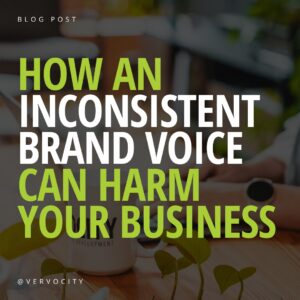Imagine a new coffee shop opening in your town. The first time you go in, the barista welcomes you with a warm smile and friendly greeting. The next day, you’re greeted with barely a nod and minimal connection.
Confusing, right?
An inconsistent brand voice works in much of the same way. Customers who’ve come to anticipate a certain level of familiarity with your communication can feel lost and disconnected when their expectations aren’t met.
Let’s take a look at how an inconsistent brand voice can affect your customers and harm your business.
A Fragmented Brand Voice Diminishes Trust
An inconsistent brand voice can swiftly and brutally diminish consumer trust. When your messages vary wildly in tone and style, it raises red flags. Are you the professional go-getter one day and the laid-back buddy the next? Your audience needs to feel like they know who you are and what you stand for. Inconsistency in communication makes that trust hard to build and easy to break.
Inconsistency Undermines Credibility
Conflicting tones in communication can make your business appear unreliable or clueless about your identity. How can your audience trust your expertise if you are unable to consistently communicate in a voice that reflects your brand values and personality? Establishing your business as an industry leader requires a voice with confidence, authority, and unwavering consistency.
Brand equity is the value derived from consumer perception rather than the product. An inconsistent brand voice undermines this perception, lowering brand equity. Every shift in tone or personality can affect the identity you’ve worked hard to establish.
Conflicting Cross-Platform Messaging Threatens Authenticity
Suppose your website highlights a commitment to sustainability and eco-friendliness, but your newsletters or social media posts rarely address these values or, worse, promote products that are not environmentally friendly. This type of inconsistency could lead customers to question your brand’s sincerity and commitment.
Mismatched Visuals and Voice Affect Brand Reception
If your visual branding (logos, color schemes, and imagery) conveys a luxury, high-end feel, but your written content is casual and humorous, the mismatch can dilute the effectiveness of your brand messaging and identity.
Inconsistent Content Quality Can Cause a Disconnect
Quality matters. Producing high-quality, insightful content on your website but sharing low-effort, poorly written content on social media platforms can reflect negatively on your brand’s commitment to quality and its audience. High standards in content quality should be a constant goal to show your audience you care about every interaction.
How to Identify Your Brand Voice
When your brand consistently uses the same voice, your marketing strategies can perform at their peak across all platforms. Here’s a quick guide to identifying your unique brand identity.
1. Understand Your Audience
Start by knowing who you are talking to. What are their demographics, interests, ages, and lifestyles? Understanding your audience at a deeper level allows you to craft messages that resonate and engage effectively.
2. Define Your Brand’s Core Values
Identify the core values that define your brand. Are you innovative, traditional, playful, or authoritative? Your brand voice should reflect your values and convey your brand personality in every message.
3. Analyze Your Current Communication
Look at your existing content and analyze the tone and style. Is it consistent? Does it reflect your brand values and appeal to your target audience? An analysis can highlight discrepancies and areas for improvement.
4. Create a Brand Voice Chart
Develop a chart that outlines the characteristics of your brand voice. Include a brief description, dos and don’ts, and examples for each trait. A chart ensures consistency across all your communications.
5. Define Your Personality
Don’t be afraid to show off your brand’s personality. If your brand were a person, how would they talk? How would they interact with your customers? Humanizing your brand makes it relatable, endearing, and memorable.
6. Write and Revise
Begin crafting content that aligns with your established voice. Use the brand voice chart as a guideline for the content you create, from website copy to social media posts.
7. Train Your Team
Share your brand voice chart with everyone in your organization, especially those involved in marketing and customer communication. Ensure they understand how to use it maintain a consistent voice.
8. Gather Feedback and Adapt
Once your brand voice is in use, collect feedback from your audience and team. Don’t be afraid to make adjustments. Your brand voice can evolve as your business grows and you learn more about your customers.
Brand consistency helps build successful businesses. At Vervocity, we’ll help your business create a brand voice that’s all you—reliable, recognizable, and awesome! Contact us to learn more about our branding services.











